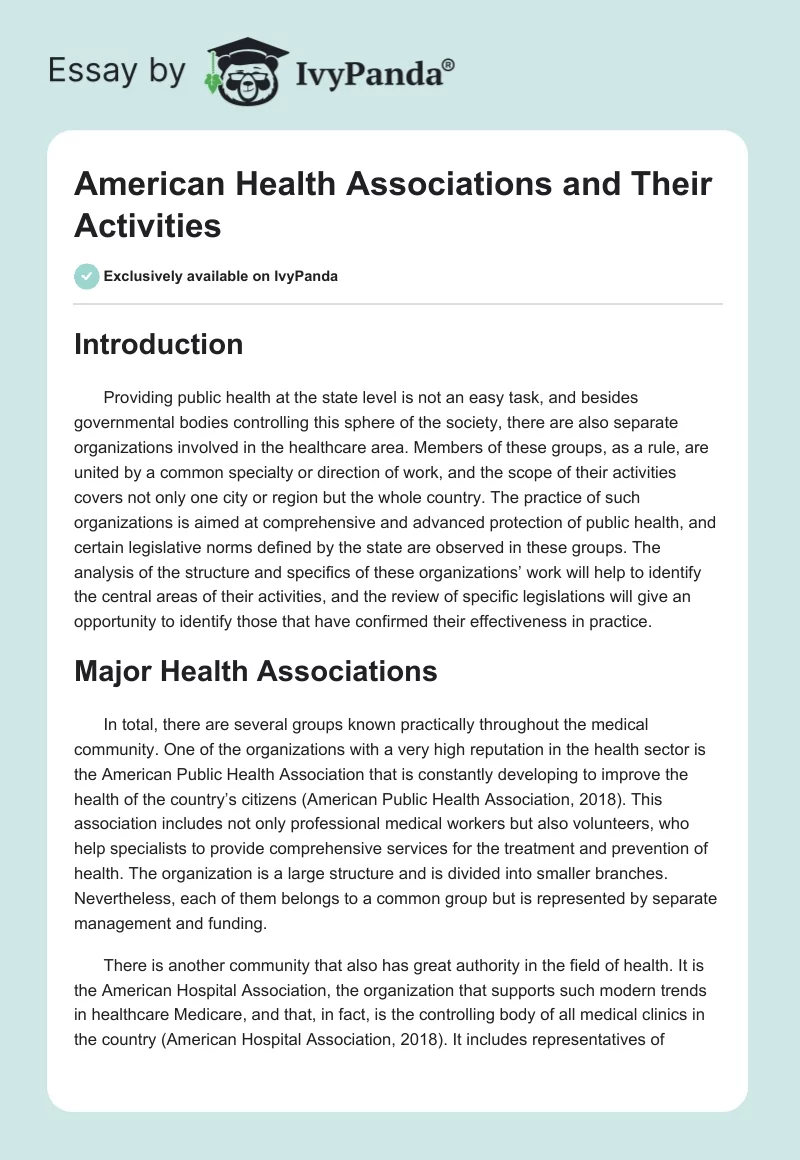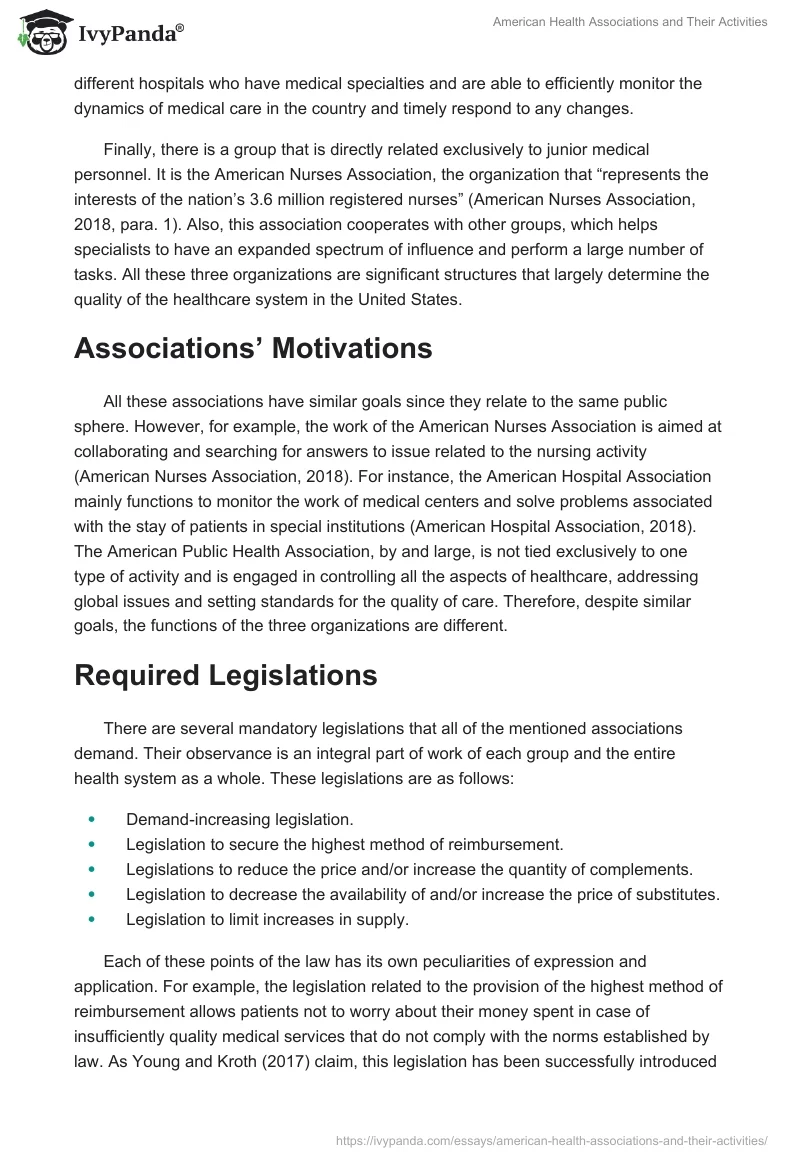Introduction
Providing public health at the state level is not an easy task, and besides governmental bodies controlling this sphere of the society, there are also separate organizations involved in the healthcare area. Members of these groups, as a rule, are united by a common specialty or direction of work, and the scope of their activities covers not only one city or region but the whole country. The practice of such organizations is aimed at comprehensive and advanced protection of public health, and certain legislative norms defined by the state are observed in these groups. The analysis of the structure and specifics of these organizations’ work will help to identify the central areas of their activities, and the review of specific legislations will give an opportunity to identify those that have confirmed their effectiveness in practice.
Major Health Associations
In total, there are several groups known practically throughout the medical community. One of the organizations with a very high reputation in the health sector is the American Public Health Association that is constantly developing to improve the health of the country’s citizens (American Public Health Association, 2018). This association includes not only professional medical workers but also volunteers, who help specialists to provide comprehensive services for the treatment and prevention of health. The organization is a large structure and is divided into smaller branches. Nevertheless, each of them belongs to a common group but is represented by separate management and funding.
There is another community that also has great authority in the field of health. It is the American Hospital Association, the organization that supports such modern trends in healthcare Medicare, and that, in fact, is the controlling body of all medical clinics in the country (American Hospital Association, 2018). It includes representatives of different hospitals who have medical specialties and are able to efficiently monitor the dynamics of medical care in the country and timely respond to any changes.
Finally, there is a group that is directly related exclusively to junior medical personnel. It is the American Nurses Association, the organization that “represents the interests of the nation’s 3.6 million registered nurses” (American Nurses Association, 2018, para. 1). Also, this association cooperates with other groups, which helps specialists to have an expanded spectrum of influence and perform a large number of tasks. All these three organizations are significant structures that largely determine the quality of the healthcare system in the United States.
Associations’ Motivations
All these associations have similar goals since they relate to the same public sphere. However, for example, the work of the American Nurses Association is aimed at collaborating and searching for answers to issue related to the nursing activity (American Nurses Association, 2018). For instance, the American Hospital Association mainly functions to monitor the work of medical centers and solve problems associated with the stay of patients in special institutions (American Hospital Association, 2018). The American Public Health Association, by and large, is not tied exclusively to one type of activity and is engaged in controlling all the aspects of healthcare, addressing global issues and setting standards for the quality of care. Therefore, despite similar goals, the functions of the three organizations are different.
Required Legislations
There are several mandatory legislations that all of the mentioned associations demand. Their observance is an integral part of work of each group and the entire health system as a whole. These legislations are as follows:
- Demand-increasing legislation.
- Legislation to secure the highest method of reimbursement.
- Legislations to reduce the price and/or increase the quantity of complements.
- Legislation to decrease the availability of and/or increase the price of substitutes.
- Legislation to limit increases in supply.
Each of these points of the law has its own peculiarities of expression and application. For example, the legislation related to the provision of the highest method of reimbursement allows patients not to worry about their money spent in case of insufficiently quality medical services that do not comply with the norms established by law. As Young and Kroth (2017) claim, this legislation has been successfully introduced into the modern Medicare health insurance system, which covers the whole country and gives citizens a possibility to rely on full-fledged medical assistance.
For example, the point of reducing the price and/or improving the quantity of complements is also essential and worthy of attention. According to the fact that pharmaceutical companies have an opportunity to independently set prices for drugs, it significantly increases their profits, but ordinary citizens’ money is spent faster. Therefore, as Young and Kroth (2017) remark, the insurance system made it possible to exclude any unnecessary costs and determine the standards for all the categories of the society so that no extra money could be wasted.
Another legislation that was successfully implemented in medical practice and used by health associations is a provision to limit the increase in supply. The peculiarity of this norm is, for example, that the excessive number of medical establishments is meaningless if few people live on a particular territory. Estimating the level of supply, according to Young and Kroth (2017), is an essential and difficult task for healthcare representatives to solve. However, it should be considered to invest funds not in unnecessary sources but in the right spheres.
Conclusion
Thus, the analysis of the health associations’ activities, as well as the consideration of the legislations list they adhere to, leads to the conclusion that different areas of healthcare are affected. Prevention and provision of comprehensive treatment of the population are key tasks that members of these organizations consider. The observance of the legislations makes it possible to improve the sphere of health and provide better medical assistance.
References
American Hospital Association. (2018). Quality & patient safety. Web.
American Nurses Association. (2018). Who we are. Web.
American Public Health Association. (2018). Our work. Web.
Young, K. M., & Kroth, P. J. (2017). Sultz & Young’s health care USA: Understanding its organization and delivery (9th ed.). Burlington, MA: Jones & Bartlett Learning.


